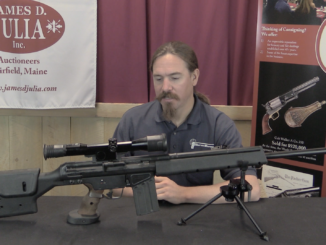There is very little documentation existing to explain the history of this rifle – all we really know is that per the receiver markings it is a Model 1936 Stendebach, and that it was brought back from Bavaria in 1945 by a US soldier who found it in a collection of confiscated firearms.
A number of German patents exist granted to one Friedrich Stendeback from 1913 to the mid 1920s, covering aspects of a toggle-locked rifle like this one. It is a delayed blowback system, with neither a recoiling barrel nor any sort of gas system. The rotary magazine can be fed by single rounds or 5-round stripper clips.
The aluminum elements of the gun raise some questions, and it seems most likely that the gun was incomplete when acquired in Germany. The firing mechanism does not appear to have been completed, which supports this suspicion. Even so, it is an interesting and unique combination of features. Hopefully more information will come out about Stendebach’s other work and potential German military testing of hist designs!




Great video!
One idea about those aluminium parts: Could it be that Stendebach originally built the rifle using regular steel parts, but then hit weight limits of some (which?) military trials, so he removed the heavier steel parts (and possibly the upper handguard, too), replacing them with aluminium parts to pass the military’s weight requirements?
Would that also present a new problem? Heat stress comes to mind as well as logistics messes. I suppose that this prototype was abandoned or forcibly yanked away from the inventor. In the former case, the guy wouldn’t want to be mistaken for a combatant. The latter scenario would have been political in nature. But I digress. Toggle actions are risky but can save axial length of the bolt stroke. The Luger does not risk slide bite, unlike the Walther PPK. The problem is designing the geometry of the action to account for forces and stresses during operation… did I mess up?
Interesting!
Oh well, seems my comment on Full30 didn’t go through, thanks to the links. Here we go again:
There are actually quite a number of patents registered with the Imperial Patent Office by a Friedrich Stendebach (mostly under the name Carl (or Karl) Friedrich Phillip Stendebach, but the applicant’s registrar is the same until the dissolution of the German Empire, so we can safely assume this to be the same person) from the late 19th century onwards, many of which deal with firearms design.
Many of these patents deal with electric locomotives, but from 1900 onwards quite a serious amount of firearms-related patents start to pop up under his name: sighting devices, projectiles for smoothbore guns, several patents regarding a “Kipplaufgewehr” (break action rifle), etc. There are no patents by this person in either 1913 or 1914, it’d be interesting where you got the information from that there were applications at that time from Stendebach.
Interestingly, the patents for the toggle lock (Kniegelenkverschluss) and rotary magazine (Walzenmagazin) were only registered in 1918 and announced in 1920 (according to the Imperial Patent Office), which was a normal time span at that time, as the patent office wasn’t reopened until 1920.
https://depatisnet.dpma.de/DepatisNet/depatisnet?action=pdf&docid=DE000000329462A
https://depatisnet.dpma.de/DepatisNet/depatisnet?action=pdf&docid=DE000000330336A
(note that the documents also includes detailed sketches of the lock and magazine of the same or a similar design as the ones in the video).
Oh, I also followed up on the name Carl Friedrich Phillip Stendebach and found this: http://www.germanhuntingguns.com/archives/archive-stendebach-carl-friedrich-philip/
Hi Ian, I have found two things for that rifle and the Waffenfabrik which presumably developed it. I also posted a comment on YouTube, but if it fails to get you’re attention there I post the same here again.
Number one: Online I could only access the index, but the full book should be available for researchers at the German national library. Here is the link for the index page: http://d-nb.info/1064919642/04
I think with the number before the 04 you should be able to access the complete work at the German national library.
Number two: http://docplayer.org/15702470-Jagd-und-sportwaffen-suhl-gmbh-35.html But this one doesn’t mention this weapon in particular. It mentions a Fa. Friedrich Stendebach Waffen- und Geschossfabriken in Suhl Thuringia and a type of ammunition he developed.
This seems to be, by far, the most complex rifle ever. The parts count alone is amazingly high, plus the number of machining operations that seem to be required, for example the rear sight and its recess in the strap on the receiver.
At no point in the video did you say “Steampunk”, which was my first impression.
Aluminum parts make sense when you are doing prototypes, as it is much easier to work. Make it out of aluminum until you get it right, then make it out of steel.
So this actual gun could never have been fired because there is no working trigger? Is that what Ian says here?
If there is no working trigger, can this even count as a prototype? Somebody could build a microwave oven with a hairdryer bolted on, inside an armchair, but it would not be a hair drying microwave armchair; just like this gun in just a trigger mechanism and a rifle sitting in a wooden stock.
Hold it! If this were to demonstrate the concept of a toggle-delayed blow-back mechanism with a rotary spool magazine and do little more, would you NEED a functioning trigger? I highly doubt the army would give Herr Stendebach live ammunition but you can’t be too sure since NO rifle is idiot-proof. Would you want to know how many “I just shot Hans in the ankle” accidents happened between 1848 and 1936 due to mishandling of a loaded-and-very-ready-to-shoot-someone-dead rifle with the safety catch turned to the fire position? I don’t want to find out if the number exceeds 400…
I really do not know. If you are building a prototype gun I would guess having it be able to, at least, cycle and pretend fire an inert round would be an absolute minimum. If you do not have a functioning trigger I would have thought no other part could be proved to be theoretically functional?